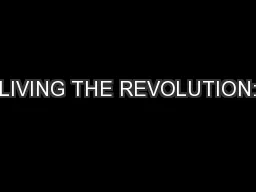/


CITY AND COUNTRYSIDE HI 168 Lecture 12 Dr Howard Chiang OVERVIEW Chinese Peoples Political Consultative Conference Mass Political Campaigns A Suppressing CounterRevolutionaries B ThreeAnti Campaign ID: 250566
Download Presentation The PPT/PDF document "LIVING THE REVOLUTION:" is the property of its rightful owner. Permission is granted to download and print the materials on this web site for personal, non-commercial use only, and to display it on your personal computer provided you do not modify the materials and that you retain all copyright notices contained in the materials. By downloading content from our website, you accept the terms of this agreement.
Slide1
LIVING THE REVOLUTION:CITY AND COUNTRYSIDE
HI 168: Lecture 12Dr. Howard ChiangSlide2
OVERVIEW
Chinese People’s Political Consultative Conference
Mass Political Campaigns
A. Suppressing Counter-Revolutionaries
B. Three-Anti Campaign
C. Five-Anti Campaign
Constitution of 1954
Building a Planned Economy:
A. The First Five Year Plan
B. Land Reform C. CollectivizationSlide3
CPPCC
Chinese People’s Political Consultative Conference: September 21-30, 1949
Common Program: 1
st statement of national policy under the new CCP govt.
2 Organic Laws: National and Standing Committee & the People’s Government
Common Program:
60 clauses
http://
www.fordham.edu/halsall/mod/1949-ccp-program.html
Mao, “On the Dictatorship of People’s Democracy” (Jun 30) – lean to one sideSlide4
http://
www.youtube.com/watch?v=3XIyb1NMZaQ
Slide5Slide6
Mass Political Campaigns
3 most important political campaigns that were launched to control and win over the urban population:
1. Movement for the Suppression of Counter-Revolutionaries
2. Three-Anti Campaign
3. Five-Anti CampaignSlide7
COUNTER-REVOLUTIONARIES
Counter-revolutionaries:
leading members of the GMD and senior officers of its army as well as the highest ranking police officers and secret agents who had worked for the former regime
Jan-Oct 1950: 13,812 arrests
Eliminate Counter-Revolutionary ElementsSlide8
COUNTER-REVOLUTIONARIES
“Regulations on the Suppression of Counter-Revolutionaries”
Also targeted leaders of traditional Buddhist and
Daoist secret societies
Mass meetings
500,000 to 800,000 deaths (Mao, 1957)
Suicides – difficult to assessSlide9
THREE-ANTI CAMPAIGN
Corruption, waste, and the culture of bureaucracy
Trial basis in Northeast by
Gao Gang
Similar to the earlier New Life Movement under GMD, but targeted govt. officials
“mass struggle movement”
Individuals singled out, humiliated, and denounced
Served as a template for future mass campaignsSlide10
FIVE-ANTI CAMPAIGN
Jan 1952: bribery, tax evasion, fraud, theft of government property, and the leakage of state secrets
directed at “national bourgeoisie” (industrialist & traders)
allow activists in workers’ organizations to examine employer’s finances
Outcome: the Party gained understanding about the workings of private sector in towns & citiesSlide11Slide12
1954 CONSTITUTION
Adopted by
National People’s Congress on September 20, 1954
Standing Committee
Chairman of the PRC
State Council
Local people’s congresses
National flag & national emblem
Democratic?Slide13Slide14
FIRST FIVE YEAR PLAN
Industrial developments had been patchy – Northeast (Jap. Occupation)
“Decisions on the Unification of the Nation’s Financial and Economic Work”: centralize finance and taxation accompanied by restrictions on the circulation of foreign currency
1952: State of Statistical Bureau & State Planning Commission
expand industry; rid of private sectorSlide15
LAND REFORM
Policy of confiscating land from the landowning classes and redistributing it to the poorest peasants
History:
- Jiangxi Soviet period (1929-35)
- United Front (1937-45) – relaxed
- Civil War (1945-49) – harsher
By 1949, CCP already quite experiencedSlide16
LAND REFORM
1950 Agrarian Reform Law:
“land ownership system…should be abolished and the system of peasant landownership should be introduced”
Criteria for classifying were complex
Work Teams: 3-30 people
1. collecting taxes
2. peasant associations – “speaking bitterness” meetings
a
new elite of village cadres emergedSlide17
COLLECTIVIZATION
Or cooperation began in 1952
1952-55: Mutual Aid Teams
1955: Agricultural Producers’ Cooperatives (APCs) – 30-40 families1956-58: High Agricultural Producers’ Cooperatives (HPCs) – 100-300 families
What did collectivization mean for the families involved?